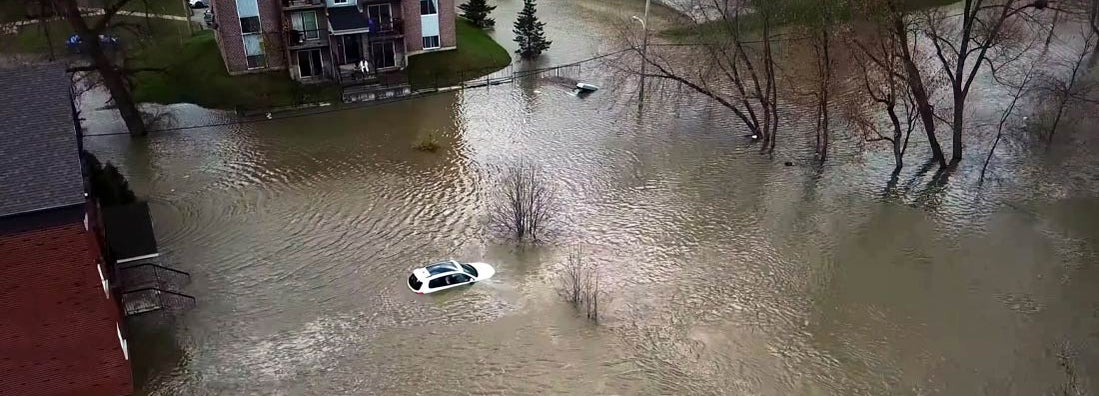Flood Insurance in Utah
Experts break down flood insurance costs, coverages, and more in Utah.

Jeff Green has held several positions at life insurance companies, Wall Street firms, and distribution organizations over his 40-year career.

Floods present a serious risk in some parts of Utah, but many insurance policies will not cover the damage caused by this hazard. If you own property in Salt Lake City or another flood-prone part of the Beehive State, you may want to give serious consideration to covering it with flood insurance.
Local independent agents live and work in your community, so they are aware of how often floods occur where you live. These agents can help you assess your risk by reviewing flood maps with you, and can help you cover your property with an affordable flood insurance policy, if needed.
Contact an independent insurance agent near you to learn more.
What Is Flood Insurance and Why Is It Important in Utah?
According to FEMA, as little as one inch of rainwater in your home can lead to as much as $25,000 in property damage. However, most home insurance, renters insurance, and business insurance policies exclude flood damage from their list of covered hazards.
That is why the US Congress created the National Flood Insurance Program (NFIP) in 1968. The NFIP offers all property owners in this country access to affordable flood coverage.
Around 9% of all properties in Utah have a 26% or greater chance of sustaining flood damage in the next 30 years. That is more than 121,000 homes and businesses, most of which are located in the Salt Lake City area. However, only about 4,000 of these at-risk properties are covered by flood insurance.
When your property is covered by a flood insurance policy, you do not need to worry that heavy rain and flash flooding will cause you large financial losses.
Is Flood Insurance Required in Utah?
Flood insurance is not required by law in Utah. However, you may be required by your financial institution to carry this coverage if both of the following are true:
- You currently have a mortgage or a home equity loan.
- Your property is located in a FEMA-designated flood zone.
If you own your property outright or if it is located in an area with low flood risk, this insurance is optional.
How Much Does Flood Insurance Cost in Utah?
The average cost of a flood insurance policy in Utah currently stands at around $735 a year, but rates are expected to increase over the next few years due to climate change causing more frequent and damaging floods across the US.
Your cost for flood insurance will be based mainly on the following factors:
- The construction and intended use of the building you are insuring
- Your property’s flood risk according to a FEMA-drawn flood map
- The amount of structural coverage you want to purchase
- The amount of contents coverage you want to purchase
If you are uncertain whether having a policy is worth the cost, keep in mind that the average payout on a flood insurance claim in Utah is $10,100.
What Does Utah Flood Insurance Cover?
Flood insurance is made up of two parts: structural coverage and contents coverage. You do not have to purchase both types. If you are a renter, you will only need contents coverage. Policies that are purchased through the NFIP cap coverage differently for individuals and businesses.
- Structural coverage: This pays to repair damage to the structure of your home or business building. It covers things like the building’s foundation, built-in appliances, permanently installed carpeting over unfinished floors, and plumbing, electrical, and HVAC systems.
- Homeowners may purchase up to $250,000 in structural coverage.
- Businesses may purchase up to $500,000 in structural coverage.
- Contents coverage: For homeowners, this can cover damage to personal belongings like furniture, clothing, electronics, portable appliances, carpeting over finished floors, and window air conditioners. For businesses, it can cover things like merchandise, supplies, computers, shelving, and other business-owned property.
- Homeowners may purchase up to $100,000 in contents coverage.
- Businesses may purchase up to $500,000 in contents coverage.
Be aware that you will have separate deductibles for your building and your contents coverage. This means that if you are filing a claim for both types of coverage, you will need to pay the deductible for each of them.
If you want to have even more flood insurance coverage than the NFIP can provide, you may want to supplement your policy with excess flood insurance through a private insurance provider. Whatever your coverage needs, an independent insurance agent can help you get the policies you need.
What Isn't Covered by Utah Flood Insurance?
As with any type of insurance, flood insurance has some limitations. You should expect your flood insurance policy to exclude coverage for:
- Furniture and other personal property kept in a finished basement
- Damage caused by earth movement, like landslides and mudslides
- Mold, mildew, or moisture remediation costs
- Damage to outdoor structures like decks, hot tubs, and swimming pools
- Loss or damage to currency, precious metals, and important papers
Flood insurance also does not provide loss of use or business interruption coverage. This means that your policy will not cover costs associated with seeking alternate housing while your home is repaired and will not reimburse your business for lost revenue if flood damage necessitates a temporary closure.
How Can an Independent Insurance Agent Help Me Get Flood Insurance Coverage?
You can turn to a local independent agent to get more information about flood insurance. These experienced agents can answer your coverage-related questions, help you evaluate your property’s flood risk, and assist you with buying an affordable flood insurance policy, if needed.
Find an independent insurance agent near you to arrange an obligation-free consultation.
https://www.floodsmart.gov/
https://floodfactor.com/state/utah/49_fsid
https://www.fema.gov/data-visualization/historical-flood-risk-and-costs
https://www.iii.org/fact-statistic/facts-statistics-flood-insurance
https://www.fema.gov/sites/default/files/documents/fema_nfip-all-flood-insurance-manual-apr-2021.pdf
